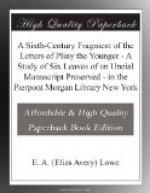[Footnote 2: On Petrus Leander, see
Merrill in Classical Philology
V (1910), pp. 451 f.]
So now the ancient manuscript itself had come. Aldus emphasizes its value in supplying the defects of previous editions. The Letters will now include, he declares:
“multae non ante impressae. Tum Graeca correcta, et suis locis restituta, atque retectis adulterinis, uera reposita. Item fragmentatae epistolae, integrae factae. In medio etiam epistolae libri octaui de Clitumno fonte non solum uertici calx additus, et calci uertex, sed decem quoque epistolae interpositae, ac ex Nono libro Octauus factus, et ex Octauo Nonus, Idque beneficio exemplaris correctissimi, & mirae, ac uenerandae Vetustatis.”
The presence of such a manuscript, “most correct, and of a marvellous and venerable antiquity,” stimulates the imagination: Aldus thinks that now even the lost Decades of Livy may appear again:
“Solebam superioribus Annis Aloisi Vir Clariss. cum aut T. Liuii Decades, quae non extare creduntur, aut Sallustii, aut Trogi historiae, aut quemuis alium ex antiquis autoribus inuentum esse audiebam, nugas dicere, ac fabulas. Sed ex quo tu ex Gallia has Plinii epistolas in Italia reportasti, in membrana scriptas, atque adeo diuersis a nostris characteribus, ut nisi quis diu assuerit, non queat legere, coepi sperare mirum in modum, fore aetate nostra, ut plurimi ex bonis autoribus, quos non extare credimus, inueniantur.”
There was something unusual in the character of the script that made it hard to read; its ancient appearance even suggested to Aldus a date as early as that of Pliny himself.
“Est enim uolumen ipsum
non solum correctissimum, sed etiam ita
antiquum, ut putem scriptum
Plinii temporibus.”
This is enthusiastic language. In the days of Italian humanism, a scholar might call almost any book a codex pervetustus if it supplied new readings for his edition and its script seemed unusual. As Professor Merrill remarks:[3]
“The extreme age that Aldus was disposed to attribute to the manuscript will, of course, occasion no wonder in the minds of those who are familiar with the vague notions on such matters that prevailed among scholars before the study of palaeography had been developed into somewhat of a science. The manuscript may have been written in one of the so-called ‘national’ hands, Lombardic, Visigothic, or Merovingian. But if it were in a ‘Gothic’ hand of the twelfth or thirteenth centuries, it might have appeared sufficiently grotesque and illegible to a reader accustomed for the most part to the exceedingly clear Italian book hands of the fifteenth century.”
[Footnote 3: C.P. II (1907), pp. 134 f.]




